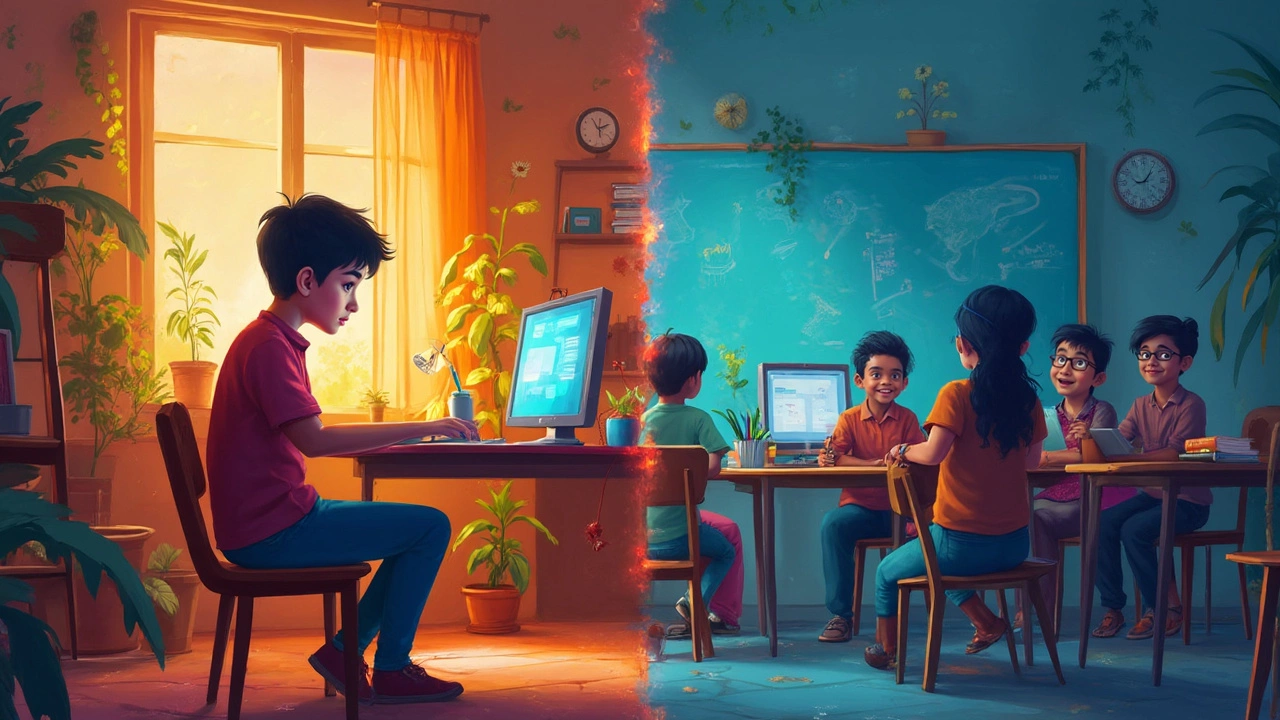Thinking about the right learning style can be quite the head-scratcher, right? You’ve got eLearning on one hand and traditional classroom learning on the other. So, what’s the deal with these two?
Let's kick things off with flexibility and accessibility. Imagine waking up and deciding you're just going to attend class in your pajamas, on your comfy couch, with a cup of coffee in hand. That’s eLearning for you. It's super flexible. You decide the time and place. No more racing through traffic to make it to class.
But what if you love the vibe of a real classroom? Some people thrive in environments where they can chat face-to-face with peers and professors. That's the strong suit of classroom learning–immediate interaction.
- Flexibility and Accessibility
- Technology and Tools
- Learning Styles and Pace
- Social Interaction and Collaboration
- Cost and Resources
Flexibility and Accessibility
Okay, let’s be real here: not everyone loves waking up at the crack of dawn to make it to an 8 AM lecture. That’s where eLearning really shines. It's like having your cake and eating it too. You get the same content, but you get to decide when and where to digest it. Have a job or family obligations? eLearning lets you work around your schedule, instead of forcing you to mold your life around school hours.
Want to study in the middle of the night with your favorite midnight snack? Totally doable. This kind of flexibility is gold for a lot of folks, especially those balancing multiple responsibilities. Plus, let's not forget about accessibility. Whether you're in a big city or the middle of nowhere, if you've got internet, you’ve got access to courses from around the globe.
On the flip side, classroom learning has its silver linings too. Sure, you have to stick to a schedule and commute, but for some, the structure is a blessing in disguise. Being in a physical location can help students stay focused and engaged. Sometimes you just can’t beat that face-to-face interaction. The immediate access to instructors and the ability to participate in live discussions? Huge plus for many learners.
Check this out: a study found that students who chose eLearning preferred it mostly because of time flexibility, while classroom students valued the structured schedule. It's all about what works for you.
Technology and Tools
Alright, let's talk tech. When it comes to eLearning, technology is your best friend. Platforms like Coursera, Udemy, and Khan Academy are packed with tools that make learning a breeze. They offer everything from video lectures to interactive quizzes and even chat forums where you can discuss with fellow learners from around the globe.
Think about it—learning with just a few taps on your device. Plus, many of these platforms use AI to customize content that matches your pace and style. And don’t get me started on virtual reality experiences that let you explore subjects like you're actually there.
On the flip side, traditional classroom learning might not always have the latest tech, but it's got chalkboards and physical resources that some learners prefer. There's something about having a textbook in hand or using a whiteboard that works wonders for certain types of learning.
Here's a quick look at how these learning styles stack up:
| Feature | eLearning | Classroom Learning |
|---|---|---|
| Content Access | 24/7, online | Set schedule, in-person |
| Tools | Videos, AI, forums | Textbooks, whiteboards |
| Interactivity | Virtual, quizzes | Face-to-face, group tasks |
You see, each has its own set of pros and cons. But in the end, it’s about choosing what fits you best. Whether you're a tech enthusiast or a fan of hands-on learning, both worlds offer plenty of tools to help you soar.

Learning Styles and Pace
Not everyone learns the same way. Some folks are visual learners, while others rely on listening to grasp the material. What about those who learn best by getting their hands dirty? This is where the beauty of eLearning and classroom learning comes into play.
With eLearning, you get to control the pace. You can hit pause, rewind, or fast-forward through lessons. Imagine watching a Netflix series! If a topic needs a little more time to sink in, you can replay it until it's crystal clear. Plus, you've got access to a plethora of multimedia resources to cater to different learning preferences.
An interesting fact: About 70% of students feel that technology in education helps them personalize their learning. This indicates the power of eLearning in accommodating unique learning styles.
- Visual learners can benefit from videos, infographics, and slide presentations.
- Aural learners can make the most of podcasts and recorded lectures.
- Kinesthetic learners can engage using interactive simulations or virtual labs.
On the flip side, classroom learning often follows a one-size-fits-all pace. Classes have set times, and teachers need to cater to everyone simultaneously. Some students might find it too fast or too slow, but it does have its perks. Direct feedback from teachers and instant problem-solving with classmates can be really helpful.
Classroom settings allow for modifications through group work, hands-on activities, and real-time discussions. It's perfect for those who thrive on structure and real-world interactions. In fact, some studies say that face-to-face learning can lead to a 50% better retention rate compared to digital modules.
| Method | Flexibility | Pace Control |
|---|---|---|
| eLearning | High | Customizable |
| Classroom Learning | Low | Fixed by Curriculum |
Choosing between these methods often boils down to personal preference. Need flexibility and love technology? eLearning might be your jam. Crave interaction and a structured pace? Then perhaps the classroom is the place for you.
Social Interaction and Collaboration
So, how do eLearning and classroom learning stack up when it comes to hanging out and working with others? Well, if you're the kind who loves a chat, the traditional classroom wins hands down for face-to-face interaction. Imagine being able to just turn to your classmate and ask if they understood what the professor just said. That’s the real-time feedback and support you get.
eLearning, on the flip side, uses tech to make up for the lack of physical presence. You’ve got forums, discussion boards, and video calls. It’s like the virtual version of a classroom where you can still get help, toss around ideas, and even form study groups. The downside? It might feel a bit distant. Sometimes, emojis don’t quite capture that puzzled look you’d give your friend in a real class.
And speaking of working together, collaboration is going digital too. You can team up with classmates from anywhere, anytime. Tools like Google Docs make working on group projects a breeze without the need to meet up in person. But there's also a slight risk you'll miss out on those spontaneous brainstorms and friendships that often start in a classroom setting.
Here’s a quick look at some ways each learning style supports interaction:
- Classroom Learning: Immediate Q&A, group projects, and social cues.
- eLearning: Flexible timing for discussions, diverse teammates, and no geographic limits.
Both options have their strong suits, but it really depends on what you value more - in-person vibes or digital convenience.

Cost and Resources
Let's get real for a moment because money talks, right? When you compare eLearning with classroom learning, costs are a big deal. One huge advantage of eLearning is the potential for cost savings. You're dodging commuting bills or pricey textbooks. Many online courses are cheaper, too, because they avoid the overhead of maintaining physical spaces. And yes, some eLearning platforms offer free courses, which is a sweet deal when you're on a budget.
Yet, don't jump the gun thinking it's all sunshine and rainbows. To really reap the benefits of eLearning, you need some tech—like a decent computer and a stable internet connection. These can pack a punch to your wallet if you’re starting from scratch. Plus, subscribing to certain premium courses or platforms can add up over time.
On the flip side, classroom learning might seem pricier upfront with tuition, housing, and materials. But think about the resources at your disposal. Libraries, labs, and even networking opportunities can justify those costs. Some students swear by the plethora of resources they can physically access in a classroom setting.
If you're into juggling numbers, here's a quick view of what the costs might look like:
| Type | Possible Expenses |
|---|---|
| eLearning | Internet bills, computer setup, platform subscriptions |
| Classroom Learning | Transportation, textbooks, on-campus facilities |
And there you have it. When it boils down to choosing between eLearning and classroom learning based on costs, it's about weighing these factors against your personal budget and educational needs. What's a priority for you might not be for someone else, so think about what really clicks for your life and wallet!
